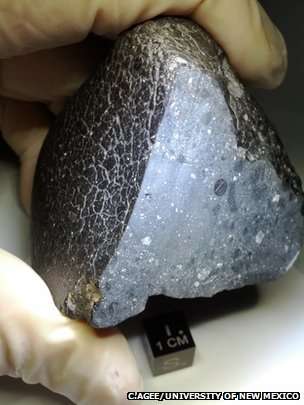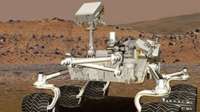By Jonathan Amos Science correspondent | January 3, 2013 | BBC NEWS Science & Environment

Weighing 320g, the stone has been given the formal name Northwest Africa (NWA) 7034 – but is nicknamed “Black Beauty”.
Its texture and chemistry set it apart from all previous objects picked up off the surface of Earth but known to originate on the Red Planet.
The researchers’ analysis, reported in Science magazine, shows the meteorite to be just over two billion years old.
The study was led by Carl Agee from the University of New Mexico, US.
“It has some resemblance to the other Martian meteorites but it’s also distinctly different in other respects,” he told BBC News, “both in the way it just looks in hand sample, but also in its elemental composition.”
There are just over 100 Martian meteorites currently in collections worldwide. They were all blasted off the Red Planet by some asteroid or cometary impact, and then spent millions of years travelling through space before falling to Earth.
Their discovery was mostly chance (few were seen in the act of falling) but their dark forms mean they will have caught the eye of meteorite hunters who scour desert sands and polar ice fields for rare rocks that can trade for tens of thousands of dollars.
Virtually all the Martian meteorites can be put in one of three classifications referred to as Shergotty, Nakhla, and Chassigny after key specimens. Scientists will often refer to these rocks simply as the SNC meteorites.
Prof Agee and colleagues argue that NWA 7034 now be put in its own class.
This rock is a basaltic breccia in character. It is made of a jumble of fragments that have been cemented back together in the high temperatures of a volcanic eruption. There are many examples of Moon meteorites that look this way, but no SNC ones.
Geochemically, NWA 7034 is dominated by alkali elements such as potassium and sodium. This is precisely what the robot rovers studying basalts down on the ground on Mars also see. This is not a trait seen in the SNC meteorites, interestingly.
Prof Agee’s team also see much more water in the new meteorite – about 6,000 parts per million. That is about 10 times more water bound into the rock than is the case in the most water-rich SNC specimens.
This says something about the environment in which the rock formed, indicating there was a much greater abundance of water to interact with the basalt.
“This rock is from two billion years ago and a lot of the SNCs are from only about 200-400 million years ago,” explained Prof Agee.
“And of course those most recent times on Mars have witnessed a cold, dry planet with a thin atmosphere. A lot of people believe that early Mars, on the other hand, was a lot warmer and a lot wetter, and maybe even a harbour for life.
“So, what happened in between? When did this transformation to drier conditions occur? Well, NWA 7034, because of its greater age, may be able to address those questions.”
Take a trip to Mars
Explore the Red Planet with Nasa’s robot










